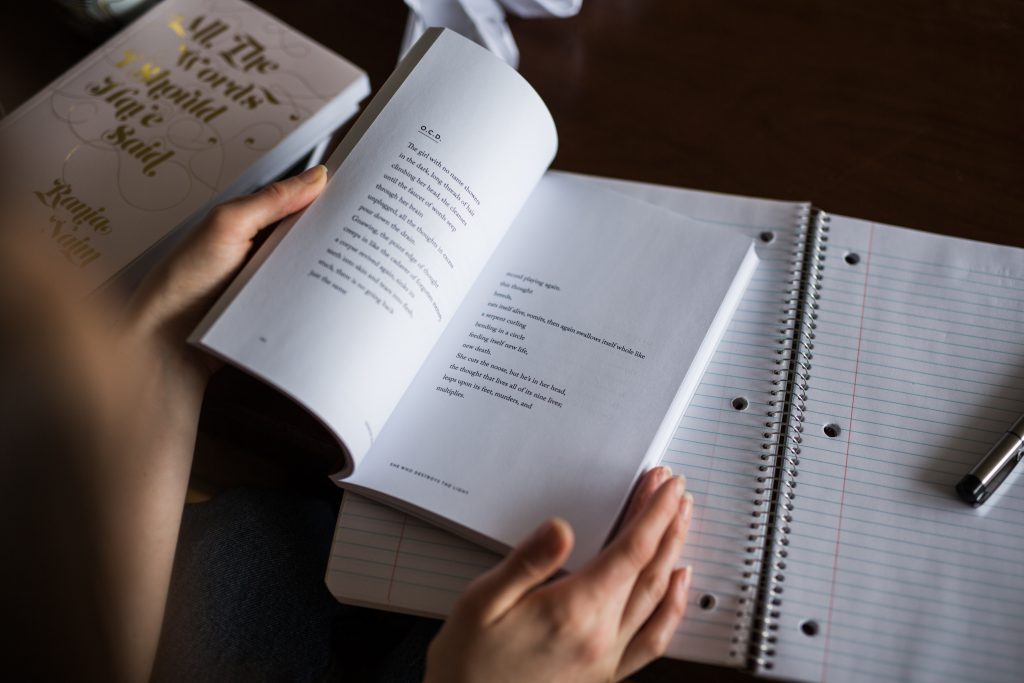

Last time we discussed a number of different poetry reading and writing myths and demonstrated how they were all untrue. Poetry’s a big field, and there’s a lot of material to cover, so let’s explore several more of the myths still surrounding this widespread spoken and written art form.
Poetry is written to express feelings. This may seem an odd statement to be considered an untrue myth – after all, isn’t poetry all about feelings? Yes, it is, but it’s important to make a distinction between the writer’s and the reader’s feelings in this case. The writer has an experience, and she paints a picture of that experience through the shaping of words, rhythm, and sounds. The reader, though, does not have access to the original experience, only to what is written on the page. The poem, then, is written to elicit feelings in the reader, hopefully ones similar to, or the same as, the writer experienced. The bottom line is that it’s the reader’s response to what’s written that’s the goal of poetry.
The poet is completely responsible for the poem’s meaning. Much like Myth #1, this is not true, and for the same reasons. The writer describes a thought, impression, or experience, but in order for the poem to work, the reader cannot be a passive participant – he must take an active role in deciphering the meaning. That includes recognizing metaphors, allusions, meter, and rhyme. It also includes bringing his own life’s experiences to the table – we perceive the world through the lens of what our lives have been like and what we’ve experienced. Ultimately, the meaning will be determined by a combination of the writer’s intent and the reader’s perception, with the larger role falling to the reader. That’s why the same poem can have such different effects on different people. Each person views it through their own unique lens.

Poetry is for girls, or sissies. Emphatically not! While there certainly have been many great women poets, dating at least as far back as Sappho (born in 615 BCE), there have been quite a number of men dominating the field: Shelley, Keats, Whitman, Robert Browning (his wife, Elizabeth, was also a poet), even Shakespeare (known primarily for his sonnets, or love poems).
And look at today’s music scene. One of the most recent poetic forms, which emerged sometime in the mid-1980s, is hip-hop, with prominent male performers such as Jay-Z, Eminem, Snoop Dogg, 50 Cent, Outkast, and Tupac Shakur. Hip-hop is the combination of words and rhythm to convey a thought, feeling, or message – a poem. As an example, look at Jay-Z’s “Smile,” from his album 4:44:
“Mama had four kids but she’s a lesbian/ Had to pretend so long that she’s a thespian/ Had to hide in the closet, so she medicate/ Society shame and the pain was too much to take/ Cried tears of joy when you fell in love/ Don’t matter to me if it’s a him or her/ I just wanna see you smile through the hate”
Read it out loud, and you can feel the rhythm he uses.
In fact, songs of all types, especially love songs, can be viewed as a vocal form of poetry; they contain structure, rhythm, refrains, and rhyme schemes. And they’re just as likely to be written and sung by men as by women, by metal and rock groups as well as by country singers. Poetry is truly an inclusive art form.
Poetry must contain correct grammar. While learning to write Standard Written English (or whatever your native language may be) is important and laudable, it may be inappropriate for – or actually hinder – artistic expression when used in poetry. Consider the haiku, the Japanese 17-syllable, three-line form. Words such as “a,” “an,” “the,” “but,” or “and” are important in SWE, but here they only use up syllables and actually break the flow of the poem; they can be deleted without losing the message. In fact, the condensed form actually strengthens the message.

The classical forms adhere to strict syllable counts or metered verse, and, again, excess words intrude on the poem’s flow. The poet must shape the important words to convey meaning in a way that also meets the form’s requirements, and that means phrasing sentences in unique ways that would never be considered “correct” by SWE standards. Take, for example, the following stanza from a kyrielle I recently wrote:
Souls seek each other ‘cross the night
Finding solace in dark places
Connections made, but are they right
Within the tangled webs we weave
The form demands four lines per stanza, eight syllables per line, and a rhyme on lines 1 and 3. To accomplish all of that and still discuss my theme, I chose to start with a strong noun-verb combination, abbreviated “across” to make the syllable count, and didn’t end the line with a period, allowing the words to flow to the next line. On line 3, I again used a strong noun-verb combination to start, but in this case I omitted the “necessary” intermediate words of SWE between them – “Connections made,” instead of “Connections are/were made.” I also reversed the order of the words to start strong – in SWE, it probably would read: “Are the connections that are made right?”, which is a much weaker sentence. Punctuation can also be used to guide the reader’s thoughts, acting almost as words. Take a look at the opening of Dylan Thomas’ famous poem “Do Not Go Gentle into that Good Night”:
Punctuation can also be used to guide the reader’s thoughts, acting almost as words. Take a look at the opening of Dylan Thomas’ famous poem “Do Not Go Gentle into that Good Night”:
Do not go gentle into that good night,
Old age should burn and rave at close of day;
Rage, rage against the dying of the light.
Though wise men at their end know dark is right,
Because their words had forked no lightning they
Do not go gentle into that good night.
The comma at the end of the first line tells you to pause only slightly then continue the words’ flow into the second line. The semicolon at the end of the second line tells you to pause before moving to the third line. The lack of punctuation at the end of Stanza 2 Line 2 tells you not to pause, that the third line will be a continuation of the second.
Poets can use punctuation in creative ways to accent or diminish words, phrases, and interpretations. If you read the poems out loud, you get a better feel for the structure and flow of how they are fashioned.
Do you know of any other myths that we haven’t covered? Please leave us a comment in the section below, and we’ll be happy to address it.
– Miriam Ruff, Content Creator, PoetsIN


Testing
How apt your observation Miriam that we do not write what we think we have written… so much of the subconscious is scrawled into those words, and that is probably what compels and calls us to continue to scratch beneath the surface beyond mistaken beliefs… to take up difficult themes… and if depth is achieved… it is this that spooks the soul of the reader. Thanks for this write 🙂 MsH
I’m glad you enjoyed it, and I appreciate your taking the time to comment. The dance between poet and reader is definitely a complex one.